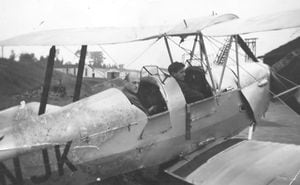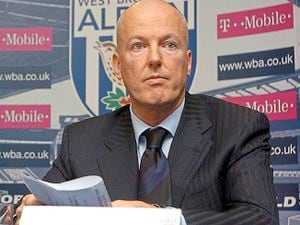This was the plane that Jack built
When Jack Holmes was a small boy in the 1930s, his father Billy would take him to the Boulton Paul aircraft factory where he worked.

He recalled a great curtain hanging from the ceiling of the hangar, and his father sternly telling him "You must never look behind that curtain, it's secret."
And like with any inquisitive youngster, that sort of warning achieved precisely the opposite effect.
"That was like a red rag to a bull to me, I peeked through the curtain and lo and behold there was a mock-up of the Defiant," Jack recalled. "It was called the wonder plane in those days."
Boulton Paul, and the Defiant in particular, would dominate Jack's life, from the moment he spotted the futuristic-looking war plane behind the curtain, to the time he stunned friends by building his own Defiant from scratch to ensure its memory lived on.
His work as the founder of the Boulton Paul Association, which not only created a museum, but saw him sharing his skills with youngsters, led to him being invited to meet the Queen at Buckingham Palace in 2012, after the group was awarded the Queen's Medal for Voluntary Service.
Tributes have been paid to the retired aircraft engineer, who lived most of his life in Codsall, near Wolverhampton, following his death on September 27 at the age of 93.
His grandson Sam Spilsbury, who lives in Stafford, said he realised from a very early age that his grandfather was totally consumed by a love of aircraft.
"I have very fond memories of visiting the heritage centre in Pendeford with my mum Pennye, dad Paul and brother Will," said Sam, who is 32.
"At this point my grandad was building the replica Defiant, which in hindsight would come to be his legacy.
"As a young lad I have to admit my interest was more in spending time with him than the heritage side of things, which is only a reflection of the kind of man he was.
"Only one thing came before the planes, and that was his family. It’s only as an adult that I’ve come to realise what a wealth of knowledge he was, and he always had time to talk to anyone that showed an interest in a subject that he dedicated his life to.”
Born in Norwich in 1927, Jack moved to Wolverhampton with his parents and younger brother Brian in 1936 when the Boulton Paul works moved lock, stock and barrel to new premises in Pendeford, just north of the town.
There was never really any doubt what Jack was going to do as a young man, and in 1940, at the age of 13, he started work as a messenger boy at Boulton Paul. As soon as he turned 16 he started work as a Boulton Paul apprentice, achieving his qualifications five years later.
He later recalled: "I was destined to go into the drawing office, but I thought 'that’s boring, I want to build aeroplanes', and in no time at all I was leading a team of men twice my age."
In an interview three years ago he said, looking back, he struggled to believe how all those experienced men would take instructions from this young upstart. But while he may have been a bit wet behind the ears, his talent for trouble shooting meant he quickly won their respect.
"The gaffer used to say 'send for Jackie Holmes – he’ll know what to do…' So I seemed to get on all right."
His apprenticeship was interrupted at the age of 18 by military call-up in 1945, but he would not see any action.
Grandson Sam said he was delighted to be selected to be trainee aircrew with the RAF, but upon arrival in Cardington Airfield, Bedfordshire, he was told his services were no longer required as the war was coming to a close.
"Faced with a few options, he stayed in the RAF as an aircraft mechanic, and saw out his time doing that before then returning back to Boulton Paul and continuing his apprenticeship on the shop floor," he said.
The Defiant entered service in 1939, with the brief of being able to fight off attacks from enemy bombers. Its advanced power-assisted turret at the rear made it quite effective in this role, but the lack of a forward-facing gun made it vulnerable to attack from German Messerschmitts, and its true potential was only realised when it was deployed as a night fighter.
And it was a plane that would fascinate Jack throughout his life.
"I can remember walking into the factory for the very first time and seeing the lines of Defiants there, what a wonderful sight," he said.
"When we were in the factory during the war it used come across the Tannoy 'the Defiants were in operation last night, they got X amount of planes' and a great cheer would go up. It was quite a morale booster. It was a very successful night fighter."
Jack had wanted to work on the Defiant from the beginning, but by the time he joined the factory work had largely switched to the Mk II night fighters. Yet it was the sometimes maligned Mk I day fighters which really captured his imagination.
So much so that when he retired from the works after 47 years, he set about building a full-sized model of his favourite plane – much to the disbelief of his friends and family, putting an incredible 50,000 man-hours into creating the replica.
"I just did it for the love of the Defiant and to try and stop the critics running the Defiant down," he said. "But when said I wanted to build one, of course they all laughed at me – they said it could never be done, but I persevered."
Much of the criticism levelled at the Defiants during the Battle of Britain related to the relatively high casualty rate among its air crew.
"It was a lovely aircraft to fly apparently, but I think the reason the Defiant didn’t perform so well in the Battle of Britain was the fault of Air Chief-Marshal Hugh Dowding and Air Chief Marshal Keith Park," he said.
"When they got short of fighters they threw the Defiant squadrons in on their own – and that was the downfall of the Defiant I’m afraid. It wasn’t a conventional fighter, it was a bomber-destroyer and was designed as such. Too often the Defiants were expected to protect airfields against fighters."
"During the Battle of France the Defiants of 264 Squadron shot down 37 aircraft in one day without loss," he said. "It was doing what it was good at, shooting down mainly bombers, but quite a few German fighters were also destroyed."
He said 264 Sqdn used a defensive manoeuvre called the 'descending spiral', which protected it from attack, but 141 Sqdn did not use this during the Battle of Britain.
Another highlight of his Boulton Paul career was working on Concorde’s power controls during his time at the company’s testing department, and he attended the supersonic airliner's maiden flight at Bristol in 1969.
Jack said much of the technology used on Concorde was being pioneered by the company as early as the 1940s.
“Controls were by hand in the early days of aircraft, but as the planes got faster and heavier, the use of mechanical controls was going out of favour, and Boulton Paul was responsible for the early days of power controls and ‘fly-by-wire’. This meant the controls were operated by hydraulic means.”
Shortly after his retirement in 1987, he joined a group of other former apprentices to form the Boulton Paul Association. The group was originally formed to keep the name of the company alive, after the firm changed its name to Dowty Aerospace.
The group was initially given a small area in one of the outbuildings at the works in Wobaston Road to store historic drawings and documents. But it was Jack's determination to build a replica of a Defiant which led to the association being given space for a museum, which would also house life-size models of a 1920s P6 Biplane and a Balliol. The latter involved 12,000 hours of work by a dozen-strong team that started with a chance discovery of two corroded and damaged cockpits in a Cumbrian scrapyard 27 years ago.
The museum was forced to close after the company's owner Moog moved to the i54 business park, and the group was based at Wednesfield High Specialist Engineering Academy up until last year.
The Defiant replica was briefly stored at the RAF Museum in Cosford before being moved to the Battle of Britain Museum in Kent.
Despite his love of planes, Jack never actually learned how to fly one. In the early 1950s he took some lessons from Wolverhampton Aero Club at Pendeford Airport, but his wife Florence was pregnant with son Paul, and he never completed the course.
Jack's wife Florence died some years ago, and he leaves a son Paul, who is 67, a daughter, Pennye Spilsbury, 62, and grandsons Sam and Will Spilsbury, and Matthew, David and Harry Holmes. A private family funeral will be held at Telford Crematorium on October 21.





